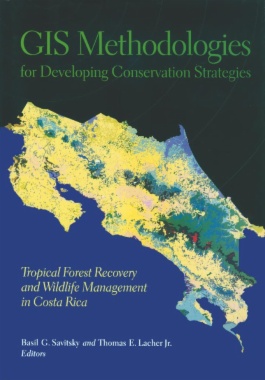Tropical habitats may contain more than a third of the world's plant and animal species; Costa Rica alone is home to one of the highest levels of biodiversity per unit area in the world, and stands at center stage in worldwide conservation efforts. Within such regions, the use of state-of-the-art digital mapping technologies—sophisticated techniques that are relatively inexpensive and accessible—represents the future of conservation planning and policy. These methods, which employ satellites to obtain visual data on landscapes, allow environmental scientists to monitor encroachment on indigenous territories, trace park boundaries through unmarked wilderness, and identify wildlife habitats in regions where humans have limited access.
Focusing on the rich biodiversity of Costa Rica, the contributors demonstrate the use of geographic information systems (GIS) to enhance conservation efforts. They give an overview of the spatial nature of conservation and management and the current status of digital mapping in Costa Rica; a review of the basic principles behind digital mapping technologies; a series of case studies using these technologies at a variety of scales and for a range of conservation and management activities; and the results of the Costa Rican gap analysis project. GIS Methodologies for Developing Conservation Strategies provides powerful tools for those involved in decision-making about the natural environment, particularly in developing nations like Costa Rica where such technologies have not yet been widely adopted. For specialists in such areas as geography, conservation biology, and wildlife and natural resource management, the combination of conceptual background and case examples make the book a crucial addition to the literature.
- Table of Contents
- Foreword, by James D. Nations
- Preface
- Abbreviations
- Part I. Overview
- 1. The Spatial Nature of Conservation and Development, by Thomas Lacher Jr.
- 2. Conservation Mapping in Costa Rica, by Christopher Vaughan, Jorge Fallas, and Michael McCoy
- Part II. Digital Mapping Technologies
- 3. Digital Mapping Technologies, by Basil Savitsky
- 4. GIS, by Basil Savitsky
- 5. Image Analysis, by Basil Savitsky
- 6. GPS, by Jeffery Allen
- Part III. Uses of GIS—Examples in Costa Rica
- 7. GIS Design and Implementation at La Selva Biological Station, by Elizabeth Wentz and Joseph Bishop
- 8. Use of Digital Elevation Models in Tropical Rain Forest Basins to Extract Basic Hydrologic and Land Use Information, by G. Arturo Sanchez-Azifeifa
- 9. Using a GIS to Determine Critical Areas in the Central Volcanic Cordillera Conservation Area, by Gregoire Leclerc and Johnny Rodriguez Chacon
- 10. Application of the HEP Methodology and Use of GIS to Improve Continental-Scale Conservation Planning, by J. David Lambert and Margaret H. Carr
- 11. The Paseo Pantera Project: A Case Study Using GIS to Improve Continental-Scale Conservation Planning. by J. David Lambert and Margaret H. Carr
- Part IV. The USAID Case Study in Gap Analysis
- 12. Overview of Gap Analysis, by Basil Savitsky
- 13. Wildlife and Habitat Data Collection and Analysis, by Basil Savitsky, Jorge Fallas Christopher Vaughan, and Thomas Lacher Jr.
- 14. Error and the Gap Analysis Model, by Jennifer N. Morgan and Basil Savitsky
- 15. A GIS Method for Conservation Decision Making, by Basil Savitsky and Thomas Lacher Jr.
- 16. Using the Gap Analysis Model for Sustainable Development and Natural Resources Management in Developing Countries, by Thomas Lacher Jr.
- 17. Application of the Gap Analysis Model in Regional and International Programs in the Tropics, by Thomas Lacher Jr., G. Wesley Burnett, Basil Savitsky, and Christopher Vaughan
- Appendixes
- Contributors
- Index

